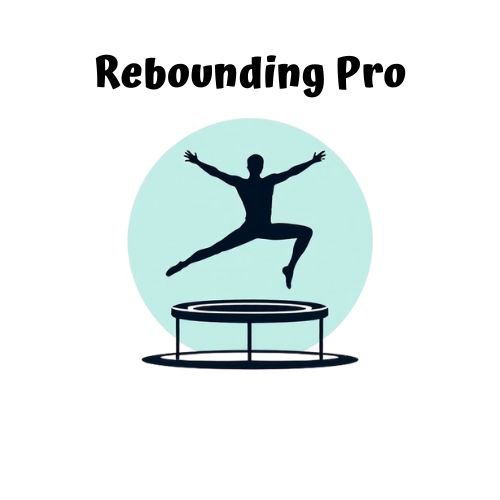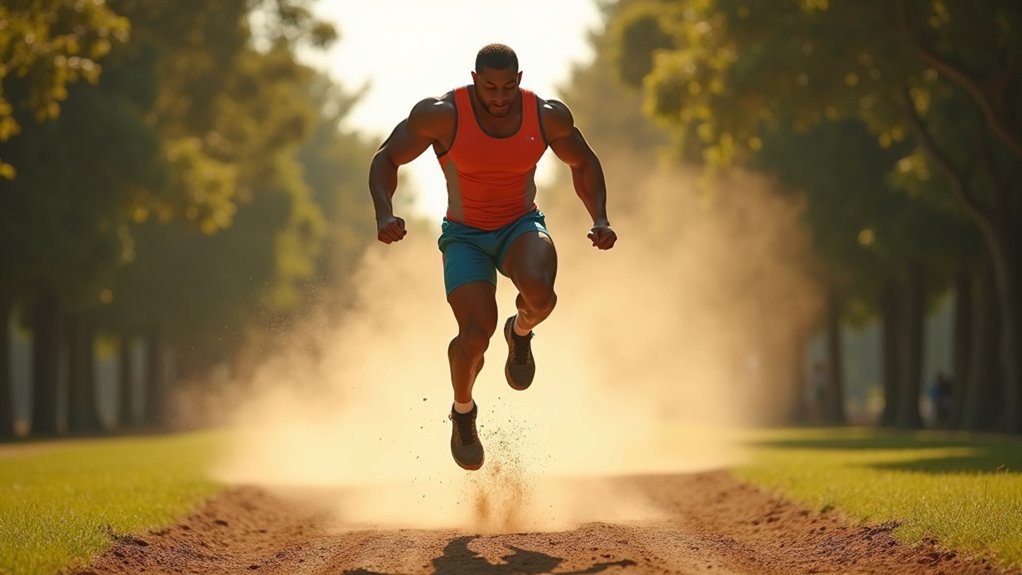Jumping burns more calories at higher weights due to physics and physiology. Your body works harder against gravity when you’re heavier, requiring more force to propel your mass upward. This increased mechanical work demands greater oxygen consumption and ATP production. For every pound of body weight, you’ll burn approximately 60% more calories compared to someone lighter doing the same exercise. Discover how this weight-based multiplier effect can maximize your rebounding workouts for faster results.
The Physics Behind Weight-Based Calorie Burning on Rebounders

When you jump on a rebounder, physics explains why heavier individuals burn more calories. Every time you lift your body against gravity, you’re performing mechanical work that’s directly proportional to your weight and jump height.
Your downward force compresses the rebounder’s elastic surface, storing energy that’s partially returned during the rebound. However, this energy exchange isn’t perfect. Heavier bodies compress the mat more, increasing energy loss through deformation and friction.
As your weight increases, the efficiency of energy return actually decreases, forcing your muscles to compensate. This means that at higher weights, you’re not only moving more mass vertically (requiring more energy per jump), but you’re also overcoming greater energy losses in the rebounder system—ultimately burning considerably more calories for the same jumping motion. This aligns with the caloric burn calculation where MET × weight is multiplied to determine the calories burned during activities like jumping rope.
How Body Mass Affects Energy Expenditure During Jumping
Your body weight dramatically influences calorie burn during jumping, as heavier mass requires greater force production to achieve lift against gravity.
When you jump, your muscles must generate enough power to propel your entire body weight upward, consuming more energy as that weight increases. According to fitness research, jumping rope can burn 120–200 kcal in just 10 minutes of activity.
This weight-calorie relationship explains why a 90kg person burns nearly 60% more calories than a 60kg individual during the same jumping routine.
Physics Drives Expenditure
As your body launches upward during a jump, physics dictates exactly how many calories you’ll burn. The equation is straightforward: heavier mass requires greater force to achieve the same height. When you jump, you’re working against gravity, generating around 1200N of force to lift your center of mass.
This relationship follows Newton’s laws—the force needed to accelerate your body scales directly with your weight. Every 0.3 meters of vertical displacement multiplies this effect. The physics principle at work here is that the net work done equals the change in kinetic energy you experience during the jump.
Your muscles convert chemical energy into both potential energy (mgh) at the jump’s peak and kinetic energy (½mv²) during movement.
The metabolic cost increases predictably with your weight because you’re performing more mechanical work with each repetition. That’s why identical jumping exercises burn considerably more calories when you’re heavier—physics makes the difference unavoidable.
Weight Magnifies Metabolic Demand
Body mass directly amplifies the metabolic cost of jumping exercises through measurable physiological mechanisms. When you carry more weight, your muscles must generate considerably greater force to propel your body against gravity, increasing ATP consumption and oxygen use. This relationship isn’t merely linear—it’s often disproportionate due to biomechanical scaling. Research shows that supporting body weight is the primary determinant of metabolic cost during movement, explaining why jumping exercises become increasingly demanding as weight increases.
| Weight Factor | Metabolic Impact | Energy System |
|---|---|---|
| Higher mass | Increased VO₂ | Greater aerobic demand |
| Force needs | Higher ATP use | Enhanced anaerobic contribution |
| Mechanical load | Elevated caloric burn | Combined system strain |
Your body responds to this increased demand through metabolic adaptations affecting both resting and activity energy expenditure. This explains why jumping at higher weights burns markedly more calories—your muscles work harder against gravity with each repetition, regardless of surface or platform used.
Comparing Calorie Burn Across Different Weight Categories

You’ll burn considerably more calories jumping at a higher body weight, with a 185-pound person consuming nearly 50% more energy than someone weighing 125 pounds during the same exercise.
This increased caloric output stems from the greater force your muscles must generate to propel a heavier body against gravity, requiring more energy production at the cellular level.
Your metabolic intensity naturally escalates with body weight during jumping activities, creating a proportional relationship between weight and calories burned that’s consistent across various high-impact exercises. This relationship applies to weight training too, where heavier individuals burn more calories during workouts compared to lighter people performing identical exercises.
Caloric Output Differentials
When comparing calorie burn across different weight categories, a clear pattern emerges: individuals with higher body weight typically burn more calories during the same activities. This principle applies universally—whether you’re weightlifting, doing aerobics, or jumping.
The science behind this is straightforward: your body requires more energy to move greater mass. For instance, during moderate weightlifting, a 185-pound person burns 133 calories in 30 minutes compared to just 90 calories for someone weighing 125 pounds. Harvard Heart Letter confirms that during physical activities like jogging at a 10-minute mile pace, the caloric expenditure differences are significant across weight categories.
Here’s why weight matters in caloric expenditure:
- Increased kinetic energy – Heavier bodies generate more force during movement
- Higher metabolic demand – More tissue requires more energy maintenance
- Greater resistance – Your body works against more weight during activities
Metabolic Intensity Comparison
Although metabolism varies widely among individuals, body weight remains a critical factor in determining caloric expenditure during jumping exercises. When you jump with greater body mass, you generate higher ground reaction forces, requiring more muscle recruitment and energy to propel yourself.
If you’re heavier, you’ll typically consume more oxygen at the same jumping cadence compared to lighter individuals, signaling greater aerobic demand. Your body also tends to tap into anaerobic energy systems earlier during sustained jumping, especially at lower cadences around 100 JPM. This metabolic shift is evidenced by higher RER values.
While your heart rate response might be similar across weight categories, the actual work performed differs substantially. This process engages multiple energy pathways simultaneously, similar to metabolic conditioning workouts. This explains why you burn more calories jumping at higher weights, despite performing identical movements.
The Metabolic Advantage of Being Heavier on a Rebounder
While many exercise activities penalize higher body weight, rebounding actually turns additional mass into a metabolic advantage. Your extra weight generates higher G-forces during each bounce—up to 3.24 times your normal body weight—demanding more muscular effort and increasing calorie burn considerably.
When you rebound with more mass, you’ll experience:
- Greater metabolic stimulation as your body works harder against resistance, potentially leading to weight loss of up to 14 pounds in just three weeks.
- Enhanced lymphatic flow that helps clear toxins and reduce cellulite more effectively.
- Increased muscle fiber recruitment throughout your lower body and core without added joint stress. This makes rebounding the King of low-impact exercise while still delivering high-intensity results.
This efficient calorie-burning mechanism makes rebounding particularly effective if you’re carrying extra weight.
Scientific Evidence: Weight as a Calorie-Burning Multiplier

Scientific research confirms what rebounders have long experienced—body weight acts as a direct multiplier in calorie-burning equations during jumping exercises.
When you jump, you’re literally lifting your entire body mass against gravity, creating mechanical work that’s proportional to your weight times the height you achieve.
The physics is straightforward: heavier individuals expend more energy because they must generate greater force to propel their mass upward.
Larger individuals burn more calories during jumping workouts—basic physics demands greater force to move more mass against gravity.
Studies show oxygen consumption increases with body weight during identical jumping routines, reflecting higher metabolic demands. This isn’t just about the upward movement—the landing phase requires significant energy for stabilization too.
Your body’s metabolic rate naturally scales with your size, as larger bodies need more energy at rest and during activity. However, research has shown that these energy expenditure differences don’t translate to greater daily calorie burn since the body employs metabolic adjustments to maintain overall energy balance.
This makes your weight a powerful amplifier of every calorie burned while jumping.
Maximizing Your Rebounding Workout Based on Your Weight
Your body weight acts as a natural multiplier in rebounding workouts, with heavier individuals burning considerably more calories during each jump.
As you progress in your fitness journey, you’ll need to adjust intensity by incorporating high-knee movements or varying bounce heights to maintain calorie-burning effectiveness. Setting realistic weight loss expectations is crucial when beginning a rebounding program, as individual results will vary based on consistency and personal factors.
Choosing the right rebounder for your weight class guarantees both safety and ideal energy expenditure, allowing you to maximize results without risking equipment failure.
Heavier Mass, Bigger Burn
Three key factors make rebounding workouts more effective for heavier individuals. When you weigh more, your body naturally burns considerably more calories during jumping exercises—someone weighing 200 pounds can burn twice as many calories as a 100-pound person doing the same workout.
- Increased cardiovascular demand – Your heart works harder when moving more mass, evidenced by higher average heart rates (137 bpm vs 127 bpm) during identical routines. This cardiovascular engagement contributes to heart health strengthening over time with consistent practice.
- Greater mechanical work – Your muscles generate more force to propel a heavier body against gravity, increasing ATP turnover and energy expenditure.
- Higher metabolic cost – Even at rest, larger body size requires more energy, amplifying the calorie-burning effect during active rebounding sessions.
Progressive Intensity Adjustments
While rebounding offers excellent calorie-burning potential for everyone, optimizing your workout based on your weight requires strategic intensity adjustments.
Start with controlled mini bounces to build foundational stability, especially if you’re carrying more weight. As you progress, gradually increase intensity by lifting your knees higher during jumps and incorporating synchronized arm movements to engage more muscle groups. For a health-focused approach, maintain feet on mat during mini bounces before advancing to more challenging moves.
Modify your routine based on heart rate goals—use stepping motions instead of jumps for lower intensity, or increase tempo for greater calorie burn. For heavier individuals, focus on slower, controlled movements to protect joints before advancing to faster paces.
Create workout variety by alternating between different moves like heel drives and jumping jacks, and implement interval training with short bursts of maximum effort followed by gentle recovery bounces.
Equipment Selection Matters
Selecting the right equipment for your rebounding workouts can dramatically impact calorie burn, especially when factoring in your body weight. Heavier ropes like the Muay Thai 2.0 or beaded varieties offer greater resistance, requiring more energy to swing and potentially burning up to 20 calories per minute. Research shows that heavy jump ropes like the Muay Thai 2.0 produce higher caloric burn compared to lighter alternatives, averaging 13.6 calories per minute.
For maximum calorie-burning results based on your weight:
- Match rope weight to body size – Heavier individuals benefit from slightly heavier ropes that provide appropriate resistance without compromising form.
- Consider adjustable options – Customizable ropes allow you to modify resistance as your strength improves.
- Ensure proper sizing – A properly fitted rope (standing on center with handles reaching armpits) optimizes your movement efficiency and prevents unnecessary strain.
Your equipment choice should align with your specific goals—whether building endurance, losing weight, or developing muscle strength.
Heart Rate Responses to Rebounding at Different Body Weights
Body weight plays a significant role in how your heart responds during rebounding exercises. If you’re heavier, your heart works harder during the same rebounding routine.
Studies show that individuals weighing around 94 kg experienced higher heart rates (137 bpm) during low-intensity rebounding compared to 58 kg individuals (127 bpm).
Research indicates heavier individuals experience more significant cardiovascular challenge during rebounding, with heart rates up to 10 bpm higher than lighter rebounders.
This increased cardiovascular effort translates directly to more calories burned. When you add handheld weights to your routine, the effect multiplies—just increasing weight from 0.91 kg to 1.36 kg can raise your heart rate by over 10 beats per minute. This cardiovascular engagement can strengthen heart muscles and improve overall heart function over time.
Higher arm movements with weights can further increase heart rate by 11.4 bpm. These physiological responses explain why heavier individuals naturally burn more calories on a rebounder, even at similar perceived exertion levels.
Calculating Your Personal Calorie Burn on a Rebounder
Three key factors determine how many calories you’ll burn during a rebounding session: your body weight, workout intensity, and duration.
Using the MET formula, you can calculate your personal calorie burn by multiplying 7.2 (rebounding’s MET value) by 3.5, then by your weight in kilograms, dividing by 200, and multiplying by your session minutes.
To estimate your rebounding calorie burn:
- Convert your weight – Divide your weight in pounds by 2.2 to get kilograms
- Apply the formula – (7.2 × 3.5 × weight in kg ÷ 200) × minutes
- Adjust for intensity – Higher intensity sessions burn more calories, regardless of weight
Our study demonstrated this principle clearly, with the heavier participant burning significantly more calories during identical workout routines compared to the lighter participant.
Weight-Specific Rebounding Techniques for Optimal Results
Customizing your rebounding workout based on your weight class greatly enhances both safety and effectiveness. Your body’s unique biomechanics require specific adjustments to maximize calorie burn while protecting your joints.
Heavier individuals should focus on controlled movements with wider stances and emphasize arm swings for momentum. If you’re lighter, you can safely perform higher jumps with quicker shifts between movements. The proper technique utilizes the 3-Step Rebounding Formula which significantly improves performance regardless of weight category.
| Weight Range | Recommended Technique | Calorie Burn Focus |
|---|---|---|
| Under 150 lbs | Explosive 12-18″ leaps | High-frequency intervals |
| 150-200 lbs | Staggered-foot jumps | Multiplanar movements |
| Over 200 lbs | 6-8″ controlled bounces | Double-bounce technique |
Remember to adjust your landing mechanics based on weight—heavier individuals need deeper knee flexion (110-120°) while lighter rebounders can utilize quicker extensions for best results.
Tracking Progress: Weight Changes and Calorie Expenditure Patterns
Monitoring your progress while rebounding requires understanding the complex relationship between weight changes and calorie expenditure. As you lose weight, your body adapts by decreasing energy expenditure, which can slow further weight loss.
Weight loss success on a rebounder demands understanding how your body fights back by slowing metabolism as pounds drop.
These metabolic adaptations vary between “thrifty” phenotypes (who conserve energy efficiently) and “spendthrift” phenotypes (who burn more calories during overfeeding).
For effective tracking while rebounding:
- Adjust your calorie intake regularly as your weight changes to account for decreasing energy expenditure.
- Monitor both exercise-related thermogenesis (from rebounding) and non-exercise activity thermogenesis (daily movement) to maximize total daily energy expenditure.
- Consider tracking intensity levels (METs) during rebounding sessions, as higher-intensity intervals can help offset the natural decline in metabolic rate that accompanies weight loss.
Remember that research shows maintaining weight loss requires substantially more effort than preventing weight gain, as the body’s energy balance system strongly resists weight loss through physiological compensatory mechanisms.
Frequently Asked Questions
Does Jumping Impact Joint Health Differently at Higher Weights?
At higher weights, you’ll experience increased joint loading during jumps. Your knees face greatest impact, potentially causing more stress damage. However, you can build joint-supporting muscles through proper progressive jumping exercises.
Can Lighter Individuals Match Calorie Burn of Heavier Jumpers?
Yes, you can match a heavier jumper’s calorie burn by increasing your jump frequency (above 120 skips/minute), extending your session duration, or using weighted equipment like heavier ropes or weighted vests during your workout.
How Does Age Affect Weight-Based Calorie Burning During Jumping?
As you age, you’ll burn fewer calories jumping due to muscle loss and metabolic slowdown. Though heavier weight still burns more calories overall, your efficiency decreases with age regardless of your weight.
Are There Genetic Factors Influencing Weight-Related Calorie Expenditure?
Yes, your genes influence metabolism, resting energy expenditure, and appetite regulation. You’ll burn calories differently based on inherited traits affecting metabolic efficiency, thermogenesis, and how your body utilizes energy during physical activities.
Does Muscle-To-Fat Ratio Affect Calorie Burn at the Same Weight?
Yes, your muscle-to-fat ratio considerably affects calorie burn, even at the same weight. You’ll burn more calories with higher muscle mass because muscle tissue is metabolically more active than fat tissue.
In Summary
You’ll burn more calories rebounding at a higher weight due to basic physics—more mass requires more energy to move. As you progress and lose weight, you’ll notice your calorie burn decreasing for the same workout intensity. Don’t be discouraged! It’s a sign of success. Adjust your routine by increasing duration or intensity to maintain effective workouts as your body transforms.





Leave a Reply